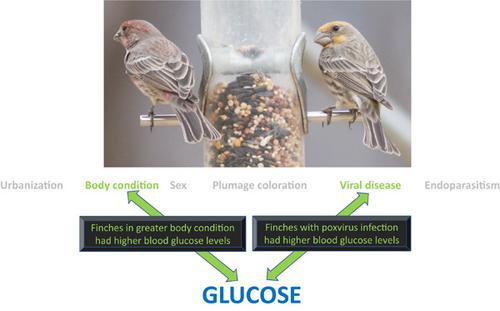当前位置:
X-MOL 学术
›
J. Exp. Zool. Part A
›
论文详情
Our official English website, www.x-mol.net, welcomes your
feedback! (Note: you will need to create a separate account there.)
Body condition and poxvirus infection predict circulating glucose levels in a colorful songbird that inhabits urban and rural environments.
Journal of Experimental Zoology Part A ( IF 1.9 ) Pub Date : 2020-06-09 , DOI: 10.1002/jez.2391 Kevin J McGraw 1 , Katherine Chou 2 , Annika Bridge 2 , Hannah C McGraw 2 , Peyton R McGraw 2 , Richard K Simpson 3
Journal of Experimental Zoology Part A ( IF 1.9 ) Pub Date : 2020-06-09 , DOI: 10.1002/jez.2391 Kevin J McGraw 1 , Katherine Chou 2 , Annika Bridge 2 , Hannah C McGraw 2 , Peyton R McGraw 2 , Richard K Simpson 3
Affiliation

|
There is widespread contemporary interest in causes and consequences of blood glucose status in humans (e.g., links to diabetes and cardiovascular disease), but we know comparatively less about what underlies variation in glucose levels of wild animals. Several environmental factors, including diet, disease status, and habitat quality, may regulate glucose circulation, and we are in need of work that assesses many organismal traits simultaneously to understand the plasticity and predictability of glucose levels in ecological and evolutionary contexts. Here, we measured circulating glucose levels in a species of passerine bird (the house finch, Haemorhous mexicanus) that has served as a valuable model for research on sexual selection, disease, and urban behavioral ecology, as these animals display sexually dichromatic ornamental coloration, harbor many infectious diseases (e.g., poxvirus, coccidiosis, mycoplasmal conjunctivitis), and reside in both natural habitats and cities. We tested the effects of sex, habitat type, body condition, coccidiosis and poxvirus infections, and expression of carotenoid plumage coloration on blood glucose concentrations and found that the body condition and poxvirus infection significantly predicted circulating glucose levels. Specifically, birds with higher blood glucose levels had higher body condition scores and were infected with poxvirus. This result is consistent with biomedical, domesticated‐animal, and wildlife‐rehabilitation findings, and the premise that glucose elevation is a physiological response to or indicator of infection and relative body weight. The fact that we failed to find links between glucose and our other measurements suggests that blood glucose levels can reveal some but not all aspects of organismal or environmental quality.
中文翻译:

身体状况和痘病毒感染可预测居住在城市和乡村环境的多彩鸣禽中的循环葡萄糖水平。
当代人们对人类血糖状况的起因和后果(例如与糖尿病和心血管疾病的联系)有广泛的兴趣,但我们对野生动物血糖水平变化的根本原因了解较少。饮食,疾病状况和栖息地质量等几种环境因素可能会调节葡萄糖的循环,我们需要同时评估许多生物特征的工作,以了解在生态和进化环境中葡萄糖水平的可塑性和可预测性。在这里,我们测量了一种雀形目鸟(雀科,Haemorhous mexicanus)的循环葡萄糖水平),已成为研究性选择,疾病和城市行为生态学的有价值的模型,因为这些动物表现出性双色的装饰色,藏有许多传染病(例如痘病毒,球虫病,支原体结膜炎),并且都居住在自然栖息地和城市。我们测试了性别,栖息地类型,身体状况,球虫病和痘病毒感染以及类胡萝卜素羽状色素的表达对血糖浓度的影响,并发现身体状况和痘病毒感染显着预测了循环血糖水平。具体地说,血糖水平较高的鸟的身体状况评分较高,并且感染了痘病毒。该结果与生物医学,驯养动物和野生动植物康复的发现相符,前提是葡萄糖升高是对感染和相对体重的生理反应或指示。我们未能找到葡萄糖与其他测量结果之间的联系这一事实表明,血糖水平可以揭示生物或环境质量的某些而非全部方面。
更新日期:2020-06-09
中文翻译:

身体状况和痘病毒感染可预测居住在城市和乡村环境的多彩鸣禽中的循环葡萄糖水平。
当代人们对人类血糖状况的起因和后果(例如与糖尿病和心血管疾病的联系)有广泛的兴趣,但我们对野生动物血糖水平变化的根本原因了解较少。饮食,疾病状况和栖息地质量等几种环境因素可能会调节葡萄糖的循环,我们需要同时评估许多生物特征的工作,以了解在生态和进化环境中葡萄糖水平的可塑性和可预测性。在这里,我们测量了一种雀形目鸟(雀科,Haemorhous mexicanus)的循环葡萄糖水平),已成为研究性选择,疾病和城市行为生态学的有价值的模型,因为这些动物表现出性双色的装饰色,藏有许多传染病(例如痘病毒,球虫病,支原体结膜炎),并且都居住在自然栖息地和城市。我们测试了性别,栖息地类型,身体状况,球虫病和痘病毒感染以及类胡萝卜素羽状色素的表达对血糖浓度的影响,并发现身体状况和痘病毒感染显着预测了循环血糖水平。具体地说,血糖水平较高的鸟的身体状况评分较高,并且感染了痘病毒。该结果与生物医学,驯养动物和野生动植物康复的发现相符,前提是葡萄糖升高是对感染和相对体重的生理反应或指示。我们未能找到葡萄糖与其他测量结果之间的联系这一事实表明,血糖水平可以揭示生物或环境质量的某些而非全部方面。











































 京公网安备 11010802027423号
京公网安备 11010802027423号